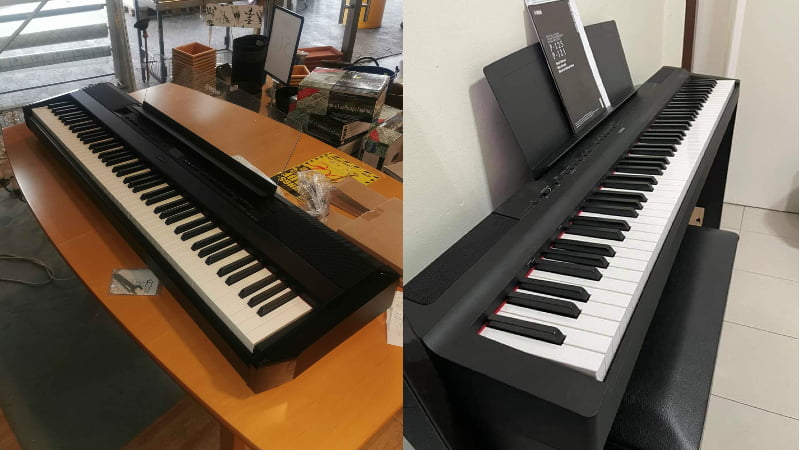When I first tried out these two pianos for this Yamaha P125 vs P515 comparison, the winner was obvious. The Yamaha P515 is the flagship model of the “P” or “Portable” Series and features everything you would want from a premium digital piano. With superior tone generation, feel, playability, and features, the Yamaha P515 beats out the P125 in almost all aspects.
With that said, that doesn’t mean the Yamaha P125 is a bad piano. In fact, the Yamaha P125 is a great option for beginners and even novice pianists on a budget. While the features aren’t as robust as the P515, it has great tones, voices, hammer action, and additional features that you won’t find in its price range.
If you’re looking for an instrument for serious piano playing and performances, the P515 is the obvious pick, but if you need a beginner’s and practice piano, then the P125 is a great budget option.
Yamaha P125 vs P515: Comparison Chart




Last update on 2025-07-07 / Affiliate links / Images from Amazon Product Advertising API
Yamaha P125 vs P515: Differences
The best way to compare these two pianos is to take a close look at the features. And when comparing the different features of the P125 and P515, the Yamaha P515 won by 3-1. This is no surprise, as the flagship model of the “P” series, the P515 contains all the best features you can get from a Yamaha digital piano such as realistic feel, crisp and bright tones, and a wide variety of different functions.
Feel & Playability
The Winner: Yamaha P515
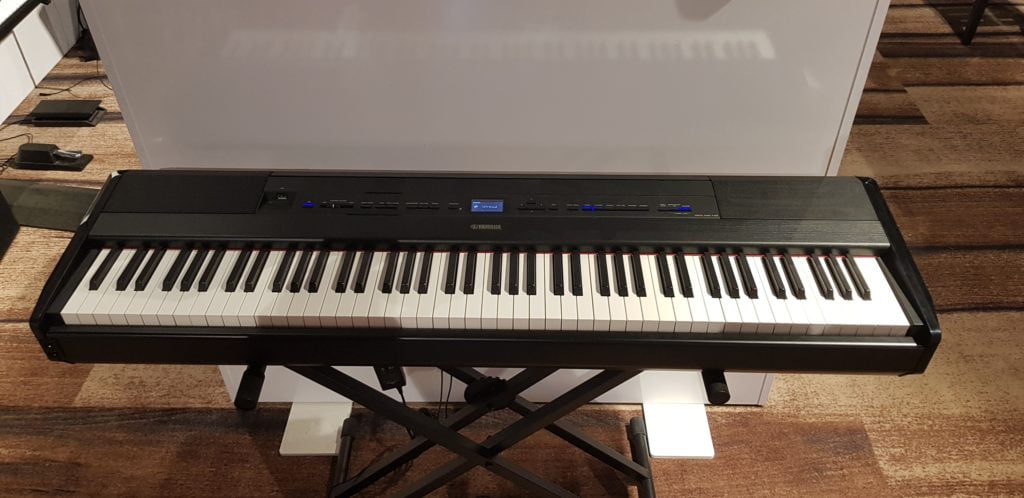
There’s no denying that the Yamaha P515 feels more like an acoustic piano than the P125. Since the P515 is much more expensive, you have to expect a superior feel compared to the P125. And with a more sophisticated hammer action system and wooden keys, the Yamaha P515 was the clear winner.
Hammer Action
The Yamaha P125 features a great hammer action system, just not as great as the P515’s. On the P125, you’ll find the GHS (graded hammer system) that’s on most Yamaha digital pianos. This is a system that mimics the action of an acoustic piano, with heavier keys on the left side and lighter keys on the light side. If you’re a beginner or even an advanced piano player, the Yamaha P125 is a great budget option since the hammer action makes it feel like playing on a real acoustic piano.
The Yamaha P515, on the other hand, uses Natural Wood X Action (NWX). This is one of the more sophisticated hammer action systems you’ll see on digital pianos. This system takes digital hammer action a step further by paying close attention to the details. For beginners, you may not feel the difference between the NWX system and the GHS, but if you’re an advanced player, it makes a world of a difference. When testing out the keys of the Yamaha P515, it really felt like pressing the keys on a grand piano because of the subtle feedback response you get.
Key Texture
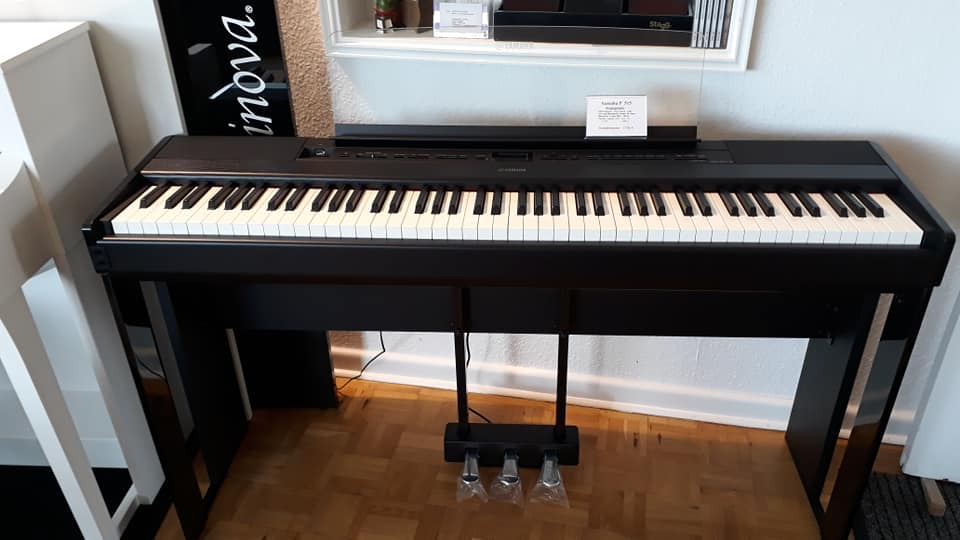
This is the feature where the Yamaha P515 really blows it out of the park. While the main complaint I have with the Yamaha P125 is the key texture, it is one of the P515’s signature features. When playing the P125, the keys had a very plastic-like feel to them, which wasn’t too big of a deal, but it was a slight let down. This is because the P125 doesn’t feature any coating to mimic the texture of the wooden keys on an acoustic piano.
On the other hand, the P515 actually features wooden white keys, which isn’t something you’ll find everyday. This is one of the main reasons the P515 really mimics the feel of a grand piano, and with synthetic ebony for the black keys, it’s hard to tell the difference of feel between the P515 and a real Yamaha piano.
Tone
The winner: Yamaha P515
With a robust tone generation system, an incredibly vast sound library, and effects that you can tweak to your tastes, the Yamaha P515 has superior tone by a mile. With that said, the P125 still features a very decent tone that can beat out most competitors in its price range.
Tone Generation
The Yamaha P515 features incredibly accurate piano sounds that can mimic the Yamaha CF and Bosendorfer Imperial Pianos. The reason for this is that Yamaha sampled these actual pianos using the CFX Binaural Sampling Method. This method uses very advanced technology to capture the “3D” sound of a piano, making for a more realistic tone recreation.
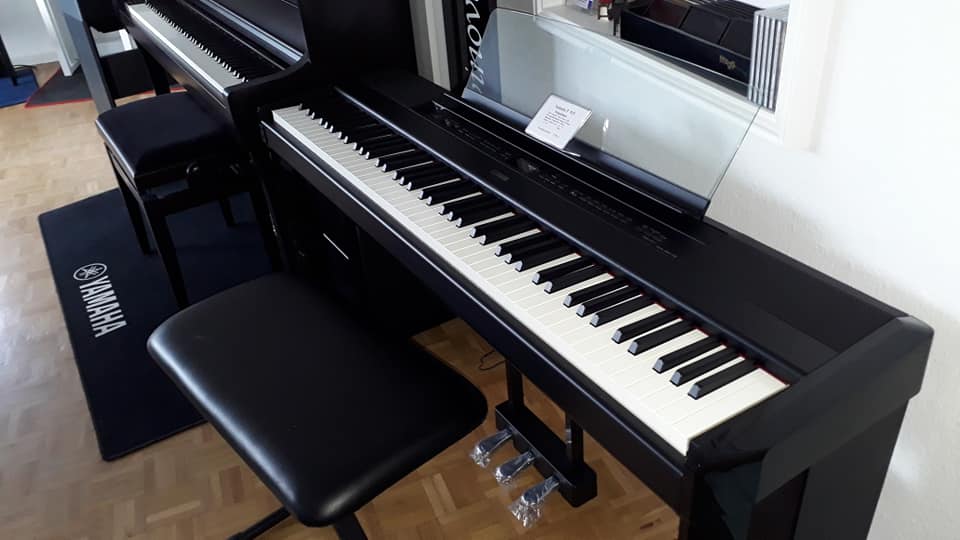
Keep in mind that Binaural sampling was only used for the Yamaha CF voices, so these tones are arguably clearer than other tones on the instrument. With that said, the advanced sampling technology used by Yamaha on the P515 allows for a wide variety of very clear, crisp, and bright tones that any pianist would love.
With the Yamaha P125, you get the PureCF Sound Engine. This is a great tone generator that uses top quality samples from the Yamaha CFIII Concert Grand Piano. This gives you accurate tones that you won’t get from other pianos in its price range. And while the PureCF Sound Engine provides for great tones, it simply doesn’t compare to the incredible technology used on the P515.
Number of Voices
Another reason I chose the Yamaha P515 as the winner when it comes to tone is the sheer number of voices on the piano. When added all together, the Yamaha P515 has a massive 500+ voices in its library. This includes 40 voices, 18 drum and SFX packs, along with 480 XG voices. Yamaha XG is an extension to General MIDI standard, and features a wide range of great voices, albeit they won’t be as high-quality as the standard voices on the P515.
This wide range and variety of tones gives you a lot of room for experimentation. If you play piano in a band, play as a solo artist, or produce your own music, the Yamaha P515 comes with just about all the sounds you’ll need to record your first track!
The P125, since it’s a great student piano, still comes with a fair amount of voices, 24 to be exact. These include great Yamaha CFIII piano tones, electric piano tones, synth, and even string voices! This is more than enough for starting out your musical journey, and even gives you a lot of room for experimentation along the way!
Effects
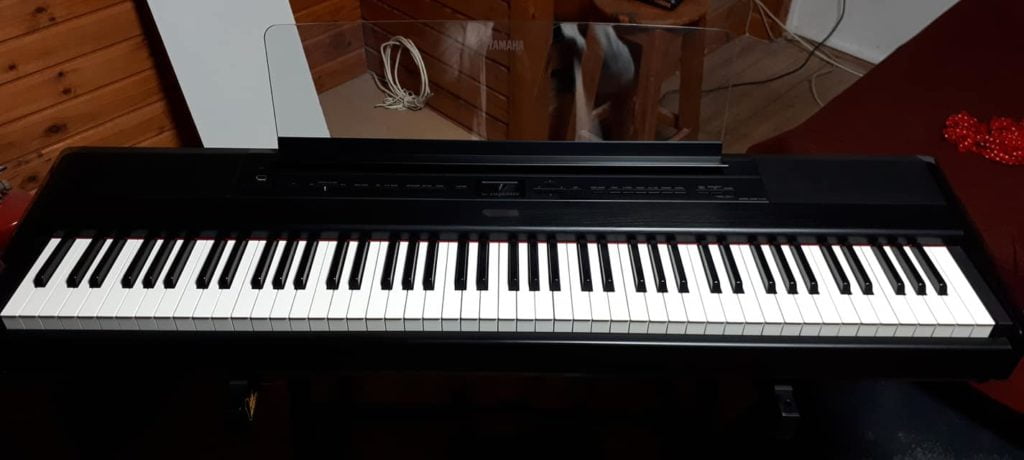
Effects aren’t exactly necessary with a digital piano, but they can be a great way to really take control of your tone. Both the P125 and the P515 come with effects, though the P515 comes with more effects and more control over the sound.
The most important effects on the P515 are probably the Chorus and Reverb. These are very common effects that you’ll hear on pianos in a lot of music, and can add a cool texture to your sound. On the P515, there are 6 different reverb presets and 4 different chorus presets to give you even more control over your sound. On top of that, the P515 also comes with a stereo optimizer and IAC, which are more passive effects but still make a huge difference to your overall tone.
The P125 comes with a decent set of effects as well, with reverb, IAC, damper resonance, and sound boost. The downside is that you don’t have as much control over these effects compared to the P515. However, if you’re just jamming with friends or experimenting with different tones, the Yamaha P125 is a great launching point.
Piano Features
The winner: Tie
This is one area where both of the pianos are tied. While the P515 offers extra connectivity options, the P125 shares all the piano features except MIDI connectivity. And considering the wide difference in price between the two models, I didn’t see enough improvement over the piano features to declare the P515 the winner despite extra connectivity options.
Polyphony
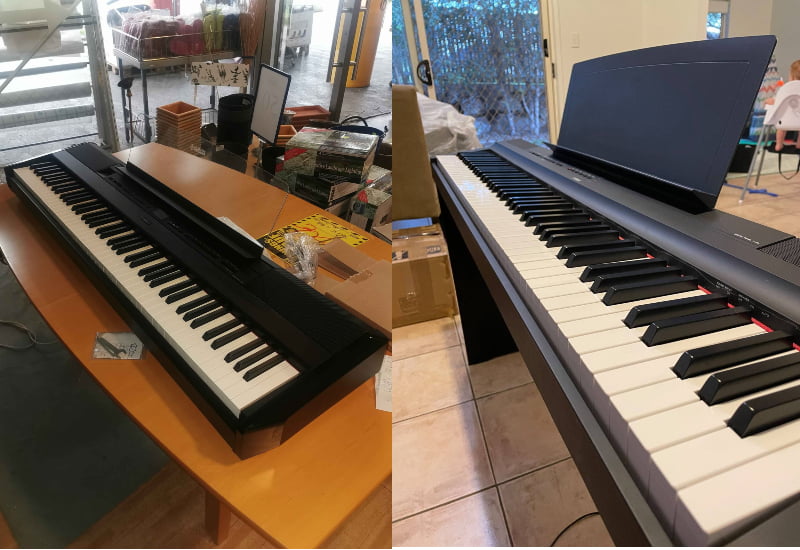
The Yamaha P515 features 256 note maximum polyphony compared to the P125’s 192. Both of these pianos allow you to play dense chords with a lot of notes without any worries, however, the larger maximum polyphony of the P515 provides a clearer and crisper tone. With that said, it’s common knowledge in the piano world that any max polyphony above 128 is overkill. So, while the P515 has incredible max polyphony, it won’t make that much of a difference when you play the instrument.
Connectivity
The Yamaha P515 comes with BlueTooth and MIDI connectivity. This allows you to use the piano as a MIDI controller for virtual instruments or for producing music. On top of that, the BlueTooth feature allows you to integrate the piano with the Yamaha Smart Pianist app. On the app, you can tweak a bunch of parameters, switch between different modes, and make precise adjustments to the tone and tuning of the piano.
The Yamaha P125, on the other hand, doesn’t have MIDI connectivity. However, certain models feature app integration, however, keep in mind that depending on your location, this feature might not be available.
Accompaniment Function
When it comes to the accompaniment function, these two models are tied. Both of them feature 21 preset songs and 50 demo songs, though on the P515 they are referred to as classics. This is more than enough for jamming and experimenting on your own. This is a great feature for beginners and novices, though the further you get in your piano journey, the less important this feature becomes.
Playing Modes
Both of these pianos come with duo mode, split mode, and dual mode. With duo mode, you can separate the keyboard into two smaller pianos with the same tuning. This is a very useful feature when it comes to piano classes, as the teacher can demonstrate or play along with the student without crossing over to the other side.
With split mode, you can assign a different voice to each side of the piano. This is a great feature when jamming with friends or performing alone. This feature gives off the illusion that you’re playing two instruments at once, which is a whole lot of fun. For example, you can assign a piano voice on the right side and a synth voice on the left for a unique playing experience.
Lastly, dual mode, also called layering mode, blends two different voices. This provides a very unique tone with a whole lot of different uses. If you’re looking to create unique sounds for a song, recording, or just a jam with friends, this is a great feature. Granted, this feature doesn’t have the most practical uses, but it’s definitely a whole lot of fun.
Yamaha P125 vs P515: The Similarities
Aside from coming from the Yamaha “P” Series, these two models don’t share too many similarities. They are both fully-weighted 88 key pianos that provide an impeccable sound, but they are made for completely different pianists.
While beginners might find the P515 fun, it’s also on the pricier side and some of the features won’t make a difference until much later in your musical journey. So, if you’re a beginner, the P125 is your best bet as it comes with decent features for beginners and novices alike.
With that said, the P515 is without a doubt the superior option. If you’re a serious pianist ready to invest in a great piano with amazing tones and professional performance features, this is your best bet.
Both of these pianos come from Yamaha, are relatively portable, and feature great features for their respective prices. However, at the end of it all, they are made for different purposes, which is why they each have their own set of pros and cons.
Quick Rundown of the Yamaha P515
- Yamaha CFX and Bösendorfer Imperial piano samples bring two of the world's finest and most prominent concert grand pianos to your fingertips
- The Piano Room lets you choose from a variety of pianos and acoustic settings to create your own personal piano environment
- Virtual Resonance Modeling (VRM) allows for vivid and richly-varied expression to reflect the limitless number of factors that create the sound of a concert grand piano
- Natural wood keyboard action with escapement and synthetic ebony/ivory key tops utilize specially dried wood to provide the same response and feel of a grand piano keyboard
- Key-off samples deliver the delicate change in sound the instant the damper falls back to the string.Number of Polyphony (Max.):256
Last update on 2025-07-07 / Affiliate links / Images from Amazon Product Advertising API
Quick Rundown of the Yamaha P125
- A fully weighted digital piano with 88 full sized piano style keys
- GHS weighted action is heavier in the low keys and lighter in the high keys, just like an acoustic piano
- The pure CF sound engine faithfully reproduces the tone of the acclaimed Yamaha 9 feet CFIIIS Concert grand piano; Tempo range: 5 to 280
- Split mode lets you play a different voice with each hand; Tuning: 414.8 440.0 to 446.8 hertz
- USB to host connectivity with MIDI and audio transfer means you only need 1 cable to connect to your music making software
Last update on 2025-07-07 / Affiliate links / Images from Amazon Product Advertising API
Product Video
Related Articles to Yamaha P515
- Yamaha DGX-660 vs P515: Is the P515 Worth the Extra Cost?
- Yamaha DGX 670 Vs P515: Which Gives You Bang For Your Buck?
Related Articles to Yamaha P125
- Yamaha P150 vs P125: The Battle of the P-Series Models
- Yamaha P125 vs CLP 625: Can a Beginner’s Digital Piano Match the Clavinova?
- Yamaha P125 vs Roland FP 60: Which is the Better Investment?
- Yamaha P-121 vs P-125: Finding the Best Portable Yamaha Piano
- Yamaha P125 vs Korg LP 380: Which Piano Is Better for Your Needs?
- Yamaha P125 vs P85: Can the Outdated Digital Piano Beat the Newer One?
- Yamaha P125 vs DGX 670: Which Piano Comes Out on Top?
- Yamaha P125 vs Korg SP 280: Which is the Better Beginner’s Digital Piano?
- Yamaha P-255 vs P-125: Finding the Better Option for Beginners
- Yamaha P125 vs YDP S34 Comparison: Does the Portable P125 Hold Up Against a Console Digital Piano?
- Yamaha P125 Vs YDP 164: Should You Get A Console Or Digital Piano?
- Yamaha YDP 103 Vs P125: Should You Get a Portable or Console Digital Piano?
- Yamaha P125 Vs Kawai ES110 Comparison: Which Is The Best Portable Digital Piano
- Yamaha P125 vs Casio PX S1000: Which Digital Piano Is Worth Your Money?
- Casio PX-870 Vs Yamaha P-125: Should You Get A Portable Or Console Digital Piano?
- Alesis Recital Vs Yamaha P125: Which Is The Right Pick For You?
- Yamaha P45 VS P115: Which P-Series Newbie Gives You More Value for Money?
- Alesis Recital Pro vs Yamaha P125 Comparison: Which Is The Best Portable Digital Piano?
- Alesis Prestige Artist vs Yamaha P125 Comparison: Why the Yamaha P125 Is the Better Investment
- Yamaha P125 vs Casio PX-770 Review: Why the Yamaha P125 Beats Out the Casio Console Digital Piano
- Yamaha P125 vs DGX 660 Comparison: Can the P125 Hold Its Own Against the DGX 660?
- Yamaha P125 vs Roland FP-30X Review: Why the Roland FP-30X Comes Out On Top
- Yamaha P115 vs P125 Review: Can the P125 Beat Out Its Predecessor?
- Yamaha P125 vs Roland FP30: A Close Battle Between Two Great Digital Pianos
- Yamaha P45 vs P125: Why the Yamaha P125 Is the Better Pick for Pianists
- Yamaha P71 vs P125: Why the Yamaha P125 Is the Better Investment
Conferences:
- P-515: https://usa.yamaha.com/products/musical_instruments/pianos/p_series/p-515/specs.html#product-tabs
- Yamaha P-515B 88-key Digital Piano with Speakers – Black: https://www.sweetwater.com/store/detail/P515BK–yamaha-p-515b-digital-piano-black
- P-125: https://usa.yamaha.com/products/musical_instruments/pianos/p_series/p-125/specs.html#product-tabs
- Yamaha P-125 88-key Weighted Action Digital Piano – Black: https://www.sweetwater.com/store/detail/P125BK–yamaha-p-125-88-key-weighted-action-digital-piano-black
Lulacruza is an electronic folk duo operating at the junction of the hypermodern and the ancient. Our music weaves together hypnotic female singing, South American folk instruments and electronic processing, while channeling pulsating waves from the source of creation.
Lalucruza is also a community where you can connect with other music lovers to collaborate, exchange ideas and share knowledge. A platform for who wants to learns the basics of playing piano, guitar, drum masters’ technique, etc.. is the premise of our website.
